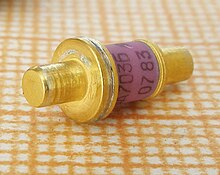
Back مقاومة سالبة Arabic Resistència negativa Catalan Negativ differentiel modstand Danish Resistencia negativa Spanish مقاومت منفی Persian Résistance négative French Negatív ellenállás Hungarian Hambatan negatif ID Resistenza negativa Italian 負性抵抗 Japanese

In electronics, negative resistance (NR) is a property of some electrical circuits and devices in which an increase in voltage across the device's terminals results in a decrease in electric current through it.[3]
This is in contrast to an ordinary resistor in which an increase of applied voltage causes a proportional increase in current due to Ohm's law, resulting in a positive resistance.[4] Under certain conditions it can increase the power of an electrical signal, amplifying it.[2][5][6]
Negative resistance is an uncommon property which occurs in a few nonlinear electronic components. In a nonlinear device, two types of resistance can be defined: 'static' or 'absolute resistance', the ratio of voltage to current , and differential resistance, the ratio of a change in voltage to the resulting change in current . The term negative resistance means negative differential resistance (NDR), . In general, a negative differential resistance is a two-terminal component which can amplify,[2][7] converting DC power applied to its terminals to AC output power to amplify an AC signal applied to the same terminals.[8][9] They are used in electronic oscillators and amplifiers,[10] particularly at microwave frequencies. Most microwave energy is produced with negative differential resistance devices.[11] They can also have hysteresis[12] and be bistable, and so are used in switching and memory circuits.[13] Examples of devices with negative differential resistance are tunnel diodes, Gunn diodes, and gas discharge tubes such as neon lamps, and fluorescent lights. In addition, circuits containing amplifying devices such as transistors and op amps with positive feedback can have negative differential resistance. These are used in oscillators and active filters.
Because they are nonlinear, negative resistance devices have a more complicated behavior than the positive "ohmic" resistances usually encountered in electric circuits. Unlike most positive resistances, negative resistance varies depending on the voltage or current applied to the device, and negative resistance devices can only have negative resistance over a limited portion of their voltage or current range.[6][14]

- ^ a b c d Sinclair, Ian Robertson (2001). Sensors and transducers, 3rd Ed. Newnes. pp. 69–70. ISBN 978-0750649322.
- ^ a b c Cite error: The named reference
Alufwas invoked but never defined (see the help page). - ^ a b Amos, Stanley William; Amos, Roger S.; Dummer, Geoffrey William Arnold (1999). Newnes Dictionary of Electronics, 4th Ed. Newnes. p. 211. ISBN 978-0750643313.
- ^ a b Shanefield, Daniel J. (2001). Industrial Electronics for Engineers, Chemists, and Technicians. Elsevier. pp. 18–19. ISBN 978-0815514671.
- ^ a b Gottlieb, Irving M. (1997). Practical Oscillator Handbook. Elsevier. pp. 75–76. ISBN 978-0080539386. Archived from the original on 2016-05-15.
- ^ a b c Kaplan, Ross M. (December 1968). "Equivalent circuits for negative resistance devices" (PDF). Technical Report No. RADC-TR-68-356. Rome Air Development Center, US Air Force Systems Command: 5–8. Archived from the original (PDF) on August 19, 2014. Retrieved September 21, 2012.
{{cite journal}}: Cite journal requires|journal=(help) - ^ a b "In semiconductor physics, it is known that if a two-terminal device shows negative differential resistance it can amplify." Suzuki, Yoshishige; Kuboda, Hitoshi (March 10, 2008). "Spin-torque diode effect and its application". Journal of the Physical Society of Japan. 77 (3): 031002. Bibcode:2008JPSJ...77c1002S. doi:10.1143/JPSJ.77.031002. Archived from the original on December 21, 2017. Retrieved June 13, 2013.
- ^ a b c Carr, Joseph J. (1997). Microwave & Wireless Communications Technology. USA: Newnes. pp. 313–314. ISBN 978-0750697071. Archived from the original on 2017-07-07.
- ^ Cite error: The named reference
Iniewskiwas invoked but never defined (see the help page). - ^ a b Shahinpoor, Mohsen; Schneider, Hans-Jörg (2008). Intelligent Materials. London: Royal Society of Chemistry. p. 209. ISBN 978-0854043354.
- ^ a b Golio, Mike (2000). The RF and Microwave Handbook. CRC Press. p. 5.91. ISBN 978-1420036763. Archived from the original on 2017-12-21.
- ^ a b Kumar, Umesh (April 2000). "Design of an indiginized negative resistance characteristics curve tracer" (PDF). Active and Passive Elect. Components. 23. Hindawi Publishing Corp.: 1–2. Archived (PDF) from the original on August 19, 2014. Retrieved May 3, 2013.
- ^ a b Beneking, H. (1994). High Speed Semiconductor Devices: Circuit aspects and fundamental behaviour. Springer. pp. 114–117. ISBN 978-0412562204. Archived from the original on 2017-12-21.
- ^ Cite error: The named reference
Gilmorewas invoked but never defined (see the help page). - ^ Kularatna, Nihal (1998). Power Electronics Design Handbook. Newnes. pp. 232–233. ISBN 978-0750670739. Archived from the original on 2017-12-21.
- ^ Graf, Rudolf F. (1999). Modern Dictionary of Electronics, 7th Ed. Newnes. p. 499. ISBN 978-0750698665. Archived from the original on 2017-12-21.
- ^ Groszkowski, Janusz (1964). Frequency of Self-Oscillations. Warsaw: Pergamon Press - PWN (Panstwowe Wydawnictwo Naukowe). pp. 45–51. ISBN 978-1483280301. Archived from the original on 2016-04-05.
© MMXXIII Rich X Search. We shall prevail. All rights reserved. Rich X Search


